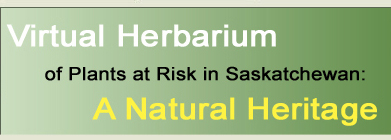|
| Hypoxis hirsuta
(L.) Coville |
|
| |
| TAXONOMY |
| |
| Family: |
Liliaceae |
| Genus: |
Hypoxis |
| |
| Species Synonyms: |
Hypoxis decumbens L.
Ornithogalum
hirsutum L. |
| Common Names: |
common goldstar
eastern yellow star-grass
yellow stargrass |
| |
| DISTRIBUTION |
| |
| Canada: |
southeastern Saskatchewan – southern Ontario
|
| Saskatchewan: |
southeastern Saskatchewan |
| Ecoregion: |
Mixed Grassland |
| |
| HABITAT |
| |
| Saskatchewan: |
mesic grasslands |
| Canada: |
moist to dry prairies and occasionally
in open deciduous woods |
| |
| RARITY STATUS |
| |
Provincial
Status According
to Harms (2003): |
Threatened |
| Nature Conservancy
Status: |
G5 S2 |
Saskatchewan
Species at
Risk Status: |
None |
| COSEWIC Status:
|
None |
| |
| Hypoxis hirsuta
is threatened in Saskatchewan because it is at the northern extent of its
range and is rarely found in this province. No immediate threats have been
identified for this species. |
| |
| SPECIES
DESCRIPTION |
| |
| Height: |
5 – 30 cm |
| Roots: |
corm subglobose to ellipsoid,
coat membranous |
| Scapes: |
filiform |
| Leaves: |
basal, 3 – 6, 5 –
26 cm long, 2 – 5 mm wide, linear, soft, essentially glabrous to densely
pubescent |
| Inflorescence: |
umbel ascending to spreading,
1 – 14-flowered; bracts 2 – 10 mm; pedicel 9 – 25 mm long,
usually twice as long as the bracts |
| Flowers: |
tepals 6 – 10 mm long,
shorter than pedicel, much longer than ovary, yellow; stamens 6, anthers
introrse; ovary inferior, densely pubescent |
| Fruits: |
capsule ellipsoid; seeds black,
lustrous |
| |
| LILIACEAE
KEY FOR GENERA FOUND IN SASKATCHEWAN |
| |
|
| 1 Leaves whitish, reduced to scales,
cladodes branched with needle-like segments; flowers axillary |
Asparagus |
| 1 Leaves green, not reduced to scales;
flowers terminal or axillary |
2 |
| |
|
| 2 At least some leaves whorled, occasionally
upper or lowermost alternate or opposite; flowers large |
3 |
| 2 Leaves all alternate or basal; flowers
small |
4 |
| |
|
| 3 Leaves ovate to rhombic |
Trillium |
| 3 Leaves linear to broadly lanceolate |
Lilium |
| |
|
| 4 Leaves linear to narrowly lance-shaped,
many times longer than wide; fruit dry |
5 |
| 4 Leaves lance-shaped to ovate, only
a few times longer than wide; fruit fleshy |
8 |
| |
|
| 5 Flowers in umbels; plants with an
onion odour |
Allium |
| 5 Flowers in racemes; plants lacking
an onion odour |
|
| |
|
| 6 Leaves with flat part of blade turned
towards stem; bulbs present; tepals segments at least 6 mm long |
Zigadenus |
| 6 Leaves with edges turned towards
stem; rootstocks present; tepals < 5 mm long |
7 |
| |
|
| 7 Stems smooth; pedicels solitary;
seeds without a tail-like appendage |
Tofieldia |
| 7 Stems glandular-pubescent; pedicels
in clusters of 2 or 3; seeds with a tail-like appendage |
Triantha |
| |
|
| 8 Leaves basal, with few on stem,
reduced upwards, grass-like |
Hypoxis |
| 8 Leaves cauline, usually without
basal leaves, wider |
9 |
| |
|
| 9 Flowers axillary, greenish-white |
10 |
| 9 Flowers terminal on stems or branches,
yellow or whitish or greenish-yellow |
11 |
| |
|
| 10 Tepals fused to form a tube; flowers
2 or more |
Polygonatum |
| 10 Tepals distinct; flowers 1 or 2
|
Streptopus |
| |
|
| 11 Stems simple; ovary with nectaries |
Maianthemum |
| 11 Stems branched distally; ovary
lacking nectaries |
Prosartes (formerly Disporum) |
|






